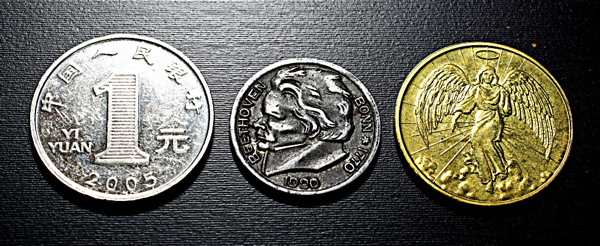I decided to cash in our bursting bowl of non-quarter coins using an automated Coinstar machine. Mr. P poured the coins into a large Zip-Loc bag (or, as he called it, “Zip-Zap” bag) and I lugged the bag across town to the single-most depressing Stop and Shop supermarket in eastern Massachusetts. Many of my previous Coinstar trips have been foiled by machines in need of maintenance, so I was thrilled to see the Coinstar appeared to be in working condition. I emptied my bag into the coin receptacle, began feeding the coins into the slot, and watched the coin tally ascend.
When the total neared $9, the satisfying tickling of processed coins was replaced by violent mechanical groaning from within the Coinstar. Many Stop and Shop customers stopped and stared at in alarm. The odd noises reminded me of a gorging all-you-can-eat-buffet-goer who, already in the throes of indigestion, is determined to squeeze in a chocolate pudding. Soon the troubled Coinstar gave up, and a message flashed across the screen: “This machine is unable to continue this transaction. Your coins are safe! Please seek the assistance of a store employee.”
Relieved over the safety of my coins but still annoyed, I went over to the customer service desk and explained the situation to a sinewy red-headed woman in her 40s whose name-tag said Kelly. “I bet you jammed it,” Kelly said in a twangy generic White Trash accent. I followed her back to the Coinstar. Kelly printed my voucher for the $9.40 that Coinstar sucessfully processed, then opened the Coinstar’s front cover with a key. “You put foreign coins in here? Can’t put foreign coins in here.”
Probably some Canadian money lurked in our coin jar, though previous Coinstar machines just returned the Canuck change without comment and certainly without malfunction. “Oh, okay,” I said. “Yep, see all these foreign coins caught in here?” Kelly muttered as she picked coins from an internal filter and placed them in front of me on the Coinstar’s receptacle.
“I don’t think all of these coins are mine,” I admitted as the pile grew. “Well, they are now, if you want them,” Kelly said, closing the Coinstar. She said I could start over and walked away, muttering warning about foreign coins like some sort of xenophobic protectionist.
When I commenced feeding the Coinstar, it immediately emitted the same disturbing noises. Exasperated and sheepish, I gathered my remaining coins and left the store. Though I didn’t begin to put a dent in the Zip-Loc bag of change, I had $9 of paper currency and a swelling handful of foreign coinage.
Of the foreign money that Kelly gave to me, the vast majority was Canadian. There was a hodgepodge of Euro and Mexican coins. Pictured below are the three most interesting coins. On the left is a Chinese Yuan, which I have never seen before. In the middle is a German coin from 1920 featuring Beethoven, issued by the city of Bonn. And on the right is a religious talisman, with both sides featuring an angel. I suppose it’s a guardian angel pocket coin, meant to protect the bearer. How these coins ended up in a Coinstar is delightfully bewildering.

